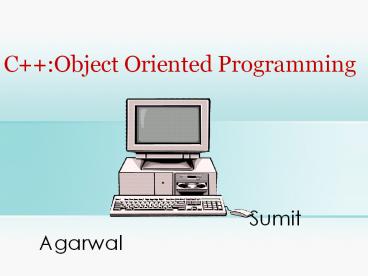OOS Concept - PowerPoint PPT Presentation
1 / 20
Title:
OOS Concept
Description:
OOS stands on Object Oriented System – PowerPoint PPT presentation
Number of Views:55
Title: OOS Concept
1
- CObject Oriented Programming
Sumit Agarwal
2
Todays session we will review
- What is Programming Language?
- What is OOP?
- Why OOP?
- Keys to OO programming
- Why C?
- Constructors
- Types of Constructor
- References
3
What Is Programming Language?
- A programming language specifies the words and
symbols that we can use to write a program. - C was developed by sir stroustrup at AT T
Bell Lab. USA in early 1980s. - Major programming paradigm are
- Procedure-Oriented Programming
- Object-Oriented Programming
4
What Is POP?
- Procedure-Oriented Programming is a philosophy
where the source code of a program is split into
functions. - Employs Top-Down Approach.
- Lack of Data Hiding Concept.
- Some examples of POP Languages are
- C
- Visual Basic
- Fortran
5
POP HYPOTHESIS
6
What Is OOP?
- Object-Oriented Programming is a philosophy
where the source code of a program is split into
reusable objects. - An instance of a class is know as an Object.
- Languages that are based on classes are know as
object-oriented. - C
- Java
7
OOP HYPOTHESIS
8
Why Object Oriented Programming?
- Employs Bottom-Up Approach.
- Provides Fault Containment.
- Cant use components (e.g., a class) in
inappropriate ways. - Provides Independence between Components.
- Design/development can be done by more than one
person.
9
Keys To OO Programming
- Class
- Object
- Data Abstraction Encapsulation
- Inheritance
- Polymorphism
- Dynamic Binding
- Message Passing
10
Why C?
- The main aim of C is to create user defined
data types such as class. This means we should be
able to initialize a class type variable(object)
when it is declared and when a variable of built
in types goes out of scope, the compiler
automatic destroys the variable. - C provides a special member function for the
above purpose called Constructor and Destructor
respectively.
11
The Interface In C
- class Car
- public
- // visible to all the functions/methods in
program. - protected
- // Visible to member function/method with in
its own and derived class. - private
- // Visible to member function/method with in
its class.
12
Reasons For Using C
- Bandwagon effect
- Low-level and high-level features
- Superset of C language
- Efficient implementation
- Multi paradigm language
13
Constructors
- It is a special member function with the same
name as its class which enables an object to
initialize itself. - A constructor is called automatically whenever a
new instance of a class is created. - If we do not specify a constructor, the compiler
generates a default constructor for us (expects
no parameters and has an empty body).
14
Characteristics Of Constructors
- Constructor should be declared in the public
section. - Constructor can not be inherited.
- They do not have return types, not even void and
therefore they can not return values. - They are invoked automatically when the object
are created.
15
Types of Constructor
- Default Constructor A constructor that accept no
argument is called default constructor. - Example studentstudent() is default
constructor. - class student
- int roll_no
- public
- student() //Default
constructor - roll_no105
16
Parameterized Constructor
- Parameterized Constructor The constructor that
can take arguments are called parameterized
constructor. - class student
- int roll_no
- public
- student(int x)
//Parameterized constructor - roll_nox
17
Copy Constructor
- Copy Constructor The copy constructor is used to
declare and initialized the object from another
object. - class student
- int roll_no
- public
- student(int x)
//Parameterized constructor - roll_nox
- student(student s)
18
Copy Constructor(Contd.)
- roll_nos.roll_no
- void display()
- coutltltroll_no
- void main()
- student x(100)
- student y(x)
- x.display()
- y.display()
19
References
- Graham Learning C(TMH)
- E. Balagurusamy- Object Oriented Programming with
C(TMH) - Bjarne Stroustrup- C Programming Language
(Addison
Wesley) - http//www.cplusplus.com
20
THANK YOU!!!






























